

 |
 |
| ON: Mr. Waldemar Scheliga, you have participated in our last edition in the section "Growers", where we learnt a little about your professional life and how you fell in love with orchids. |
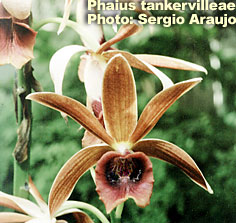 |
In
that interview, you talked about your predilection for Cattleya maxima,
about your success with Phaius tankervilleae and Phragmipedium
longifolium, about your secret tip to fertilize, brief, a little about
your cultivation all along 57 years. Now, we would like to go on with our
conversation, talking a little more about all this and mainly approaching
the orchidophilia in general. Just for curiosity, why did you pay R$ 700,00 for one plant? Was it that wonderful? WS: - Ah! That foolish thing!! I was charmed with that plant. We do not meet a Cattleya schilleriana coerulea every day. It was well worth because along some years, I enjoyed it. This species also blooms in Petrópolis (Mountain region of the state of Rio de Janeiro). |
| Quinta do Lago nursery brought to a show a wonderful clump of Cattleya schilleriana, I've never seen something like that one. |
| However it does not happen every day. For example, this clump of Calista densiflora (Dendrobium densiflorum) took time to bloom this way. ON: How long have you had this plant? WS: Since 1983. It bloomed last year with 46 spikes. It took 18 years to bloom. However, I have some others that bloom every year. |
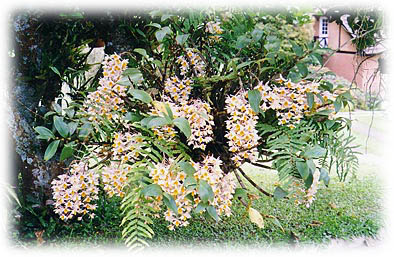 |
| ON:
Also with 46 spikes? WS: No, I also have Dendrobium thyrsiflorum. Some years ago, when I was an active member of the association, I still had car and brought it to a meeting at OrquidaRIO (our local society). Everybody loved it, everybody wanted a cutting scion. ON: What bring someone wait 18 years for a blooming; stubbornness, obstinacy? WS: Stubbornness or that hope of seeing it blooming, we think let's wait for the next year, let's see... However, it will not bloom again so earl. This year, in Petrópolis Coelogyne cristata will bloom very well. It likes cool weather, all those years that we had a warm winter, it did not bloom. Now, it has a wonderful blooming. ON: Do you think that Calista densiflora just blooms in cool weather? WS: It likes cool conditions and does like sun, it likes a shade place. I also have Dendrobium fimbriatum which blooms very well. All of them placed in a very small pots, with the roots outside, instead of repot them, I put in a bigger pot and so on. I have plant that is placed in 3, 4 pots, each time bigger. Dendrobium does not like big, large pots. The problem is that it grows fast, becoming bigger and the small pot can not sustain it and loses the balance. |
| ON:
Just to satisfy the curiosity about your cultivation.
Acacallis cyanea, you cultivate it here, in Rio de Janeiro, in warmer conditions. And Acineta and Aerangis where do you cultivate them? WS: I cultivate them in Petropolis (mountain region). |
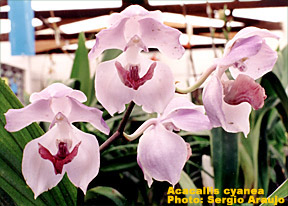
|
|
ON:
And Arpophyllum? |
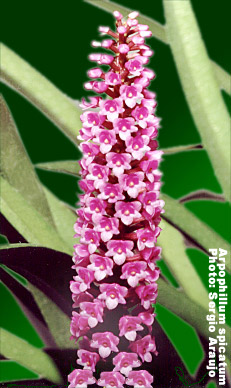 |
ON: What is your most rare plant? WS: Cattleya maxima that we can not find very often in the collections. ON: It is rare even in orchids shows. Lycaste matogrossensis is not very common either... WS: I have a wonderful hybrid. Where I bought it, nobody knew the composition but I found it later. Lycaste Lucianii, Lycaste lasioglossa x L skinneri.It is very beautiful, the flower is big, it is really very beautiful. I have Lycaste cruenta. However the most wonderful to me... I always think and still think is Cattleya maxima and Laelia purpurata carnea. I have three pots, that big which bloom with really wonderful clusters. ON: And Laelia purpurata, do you have them in Petrópolis? WS: Yes, I cultivate there. Recently I had a trouble with Cattleya's fly. It is a calamity. The cycle takes six months and the only way is to prevent from new reproductions. ON: Mr. Scheliga, before you start reducing your plants, which was the dimension of your collection? WS: I always had more or less the same quantity because when I reached this number, I stopped. |
| I mean I get rid of some but as they grown very well, they multiply easily. It is the same history old: I want to reduce but I can not. It increases automatically and I do not have the courage to throw them away. I have just sold to Maurício, from Binot nursery, the pots of Phaius and a great quantity of Coelogyne, Potinara, and so on. I can not withstand because I have no more conditions to be so active. Every time I got there, in the weekend, I have many plants to repot and this provokes a pain in my back. No way! They reproduce themselves a lot. Coelogyne is a mad thing, for example. |
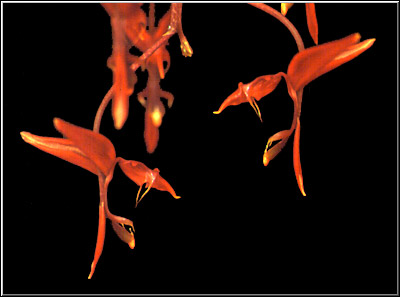 |
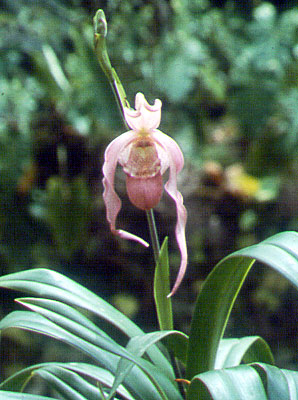 |
ON:
Since you became interested, how did you start your learning? How did you got the great knowledge you have nowadays? Were you a member of à Sociedade Fluminense de Orquidófilos (Orchid association of the State of Rio de Janeiro)? WS: No, I wasn't. In a moment, I got into the S.B.O. (Orchid Brazilian Society) and there I met many other orchidophiles and, little by little, I improved my knowledge about this subject. However we got to the point of being annoyed by the direction. The same people had the power for eight years and became, as I can say, to much negligent. There was no interest. The companions did not learn any thing, brief. Once, por example, they decided to bring an American film about a pine tree forest. What was the interest to us? For all those reasons, a group of 37 associates, included myself, decided that in the next election, we would choose a new board of directors. |
| We
present a ticket and called it "Renovation" and Zico from Florália
was also in it. However that direction finished for playing a trick on us
and set the assembly to 8:00 pm. They arrived earlier, voted and won for
2 votes. Those two votes were from two companions who went back on their
words, at the last time. Thus, we did not got our own direction. We felt
down and went to Bar Luiz (traditional German restaurant in Rio), to drink
draft beer to forget our heartaches. Right there, we decided to create a new association and we did. Right there, we made up our mind. |
| ON:
Thus OrquidaRIO was born? When did it happen? WS: In 1986. OrquidaRIO was born practically in the Bar Luiz. Drinking draft beer and eating potatoes salad. The first meeting took place in a country place owned by Luiz Clemente Ferreira de Souza, one of our companions who had this propriety in Ladeira Novo Mundo, between Laranjeiras and Botafogo (in Rio de Janeiro city). Later, we moved to Sorocaba Street, in a school called Tico Tico. We set down in very small seats; For some years, we stayed there; This school was owned by Carlos Eduardo de Britto Pereira's mother. We did not pay anything, it was free. We decided to have our own head office. We started to deal with the firemen corporation a terrain that they have in Copacabana, where there is a small wood. I can not remember the name of the street, near to Cardeal Arcoverde place, where there is nowadays a subway station. We have even dealt with the Government and they allowed the construction of a nursery and a head office but the money lacked. Nobody had the money and it was very difficult to find sponsors because it would be a very expensive construction. The idea finished to die and nobody did anything. ON: Who participated in the association when you got in? WS: Zico, Jorge Verboonen, Exdras Porto... All those people. Exdras Porto and Jorge Verboonen were the last shareholders of S.B.O. |